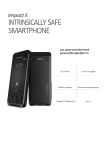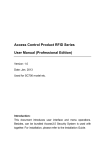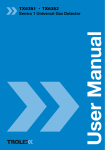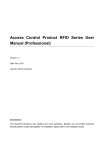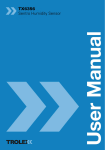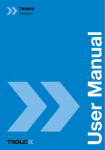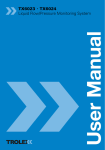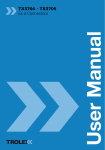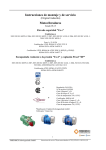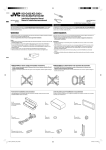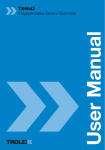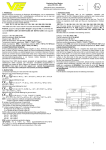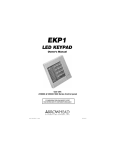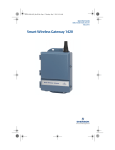Download TX6386/7 User Manual
Transcript
TX6386 • TX6387 User Manual TX6386 • TX6387 High Visibility and Extra Large Display Methane Monitor Contents 1. Product Overview 4 5.Operation 25 1.1 Operating Features 25 5 5.1 1.2Application 5 6.Calibration Normal Operation 28 1.3Dimensions 6 6.1 Prepare to Calibrate 28 1.4 Technical Information 7 6.2 Calibrate Zero 29 1.5 Electrical Details 10 6.3 Calibrate Span 29 2.Certification 11 7.Maintenance 30 2.1 Europe (ATEX) 11 7.1 Output Signal 30 2.2 Australia (IECEx) 11 7.2 Annual Safety Check 30 2.3 Russia (Customs Union) 11 7.3 Damaged Sensors 31 3.Installing 12 7.4 Record Keeping 31 3.1 Safety Precautions 12 7.5 Maintenance and 3.2 Tools and Test Calibration Log Equipment Required 13 8.Repair 3.3 Siting Recommendations 32 33 14 8.1 3.4Connections 15 Replace Local and Remote Sensor - 4. Setup and Calibration 16 8.2 Local and Remote Sensor 4.1 Controls and Indicators 16 Filters - Replace 34 4.2 Output Relays: 9. Spare Parts 34 Warning Alarm - RL1 and 10.Disposal 35 High Alarm - RL2 33 21 Disclaimers36 4.3Power-up 22 Trademarks36 4.4 Self-check and Diagnostics 22 Contact Details 36 4.5 SP1 and SP2 Buttons 23 Document History 36 4.6 Output Relay - SP1 - Warning Alarm and SP2 - High Alarm Adjust www.trolex.com 24 TX6386/7-UM-EN-04 3 1. Product Overview 4 TX6386 High visibility methane monitor with locally or remotely mounted gas sensing module - locally mounted gas sensing module shown. TX6387 Extra large display methane monitor with remote gas sensing module. TX6386/7-UM-EN-04 www.trolex.com TX6386 • TX6387 User Manual 1.1 Operating Features • • • • • • • • • • • High visibility safety monitoring of methane gas hazards present in the atmosphere High accuracy poison resistant catalytic combustion sensors, calibrated for methane High brightness LED display can be viewed at distance, even in totally dark conditions. Two high visibility display sizes: 20 mm (0.8 inch) - TX6386 OR 100 mm (4 inch) high characters - TX6387 Periodic self-check routine of all sensor conditions Convenient calibration of zero and span Signal clamp after gas over-range with manual reset Two independent output contacts with adjustable setpoints for local control and alarms Sturdy waterproof construction for use in extreme working environments Intrinsically safe for use in Group I hazardous areas Optional formats; remote sensors mounted in a compact machined metal housing for use on machinery where space is limited, also available with integrally mounted gas sensing modules 1.2Application Fixed point methane gas detection for safety monitoring in Group I applications. Group I: TX6386 and TX6387 www.trolex.com Supply Voltage: 12 V dc TX6386/7-UM-EN-04 5 1.3Dimensions 1.3.1 TX6386 - High Visibility Methane Monitor 1.3.2 TX6387 - Extra Large Display Methane Monitor 6 TX6386/7-UM-EN-04 www.trolex.com TX6386 • TX6387 User Manual 1.4 Technical Information 1.4.1 TX6386 - High Visibility Methane Monitor 3 1 2 1.4.2 TX6387 - Extra Large Display Methane Monitor 3 1 2 www.trolex.com TX6386/7-UM-EN-04 7 1.4.3 Technical Details 1 2 Supply voltage 8.5 to 14.4 V dc Current consumption 160 mA (typical) Output 2 normally open contacts (held closed when system is healthy) Alarm output contacts Contact rating: Maximum current: 1 A Maximum voltage: 230 V ac Suitable for switching approved intrinsically safe circuits RL1: Warning Alarm - independently adjustable setpoint (SP1) RL2: High Alarm - independently adjustable setpoint (SP2) 3 Gas detected Methane 0 to 4% v/v Operating life Greater than 5 years in clean air Operating temperature range -10 to +40°C (14 to 104°F) Storage temperature -20 to +60°C (-4 to 140°F) Humidity 95% non-condensing Housing materials Housing: Polycarbonate / ABS Gas sensor: Local: Machined stainless steel Remote: Machined stainless steel and brass Gas sensor connection: Flexible armoured conduit Protection classification Housing: IP65 Gas inlet port: IP54 Weight 450 g (1 lb) Mounting TX6386: TX6387: 8 TX6386/7-UM-EN-04 Two 6 mm (0.23 inch) diameter fixing holes Four 6.5 mm (0.25 inch) diameter fixing holes www.trolex.com TX6386 • TX6387 User Manual Cable entries 3 x M20 Electrical connections 4 mm (0.15 inch) barrier/clamp terminals Conductors A maximum of two per terminal Conductor size A maximum of 2 x 2.5 mm² (0.003875 inch²) Terminal torque 2.4 Nm maximum Display TX6386: TX6387: Vibration limits (BS 2011) 10 to 100 Hz: 0.25 mm (0.009842 inch) peak 100 to 600 Hz: 2 g peak Impact limits 20 joules (housing) Ambient pressure limits 1013 mbar ± 100 mbar absolute Sensing principle Catalytic combustion Linearity Linear: 0 to 3% v/v ± 0.2% v/v: 3 to 4% v/v Drift ± 0.25% v/v per month (at 25°C (77°F)) Response time (T90) < 20 seconds Warm up time < 5 minutes in air or 1% v/v CH4 (to 95% stated accuracy) Calibration Front mounted potentiometers Over range If the measured gas concentration exceeds the calibration range of the sensor, the display will indicate FAULT Pellistor protection The supply to the gas sensing element will be switched off to prevent oxidisation damage occurring if the gas concentration exceeds safe limits. The sensor will remain switched off until reset. www.trolex.com 7 segment, high brightness LED, 20 mm (0.8 inch) characters 7 segment, high brightness LED, 100 mm (4 inch) characters TX6386/7-UM-EN-04 9 1.5 Electrical Details Mining Ex TX6386 and TX6387 2 wire remote powered Supply voltage 12 V dc Supply current 160 mA (typical) 10 TX6386/7-UM-EN-04 www.trolex.com TX6386 • TX6387 User Manual 2.Certification 2.1 Europe (ATEX) Ex Certificate number:Baseefa 12ATEX0060 Ex Certification code: I M1 Ex ia I Ma (Ta = -20°C to +55°C) General Conditions of Use: Prior to installation, it is essential that user refers to the above certificate to ensure that the termination and cable parameters are fully complied with and are compatible with the application. Copies of certificates are available from Trolex. ATEX Directive (94/9/EC) 2.2 Australia (IECEx) Ex Certificate number:IECEx TSA 11.0047X Ex Certification code: Ex ia I Ma General Conditions of Use: Prior to installation, it is essential that user refers to the above certificate to ensure that the termination and cable parameters are fully complied with and are compatible with the application. Copies of certificates are available from Trolex. 2.3 Russia (Customs Union) Ex Certificate number:TC RU C-GB.ГБ05.B.00356 Ex Certification code: PO Ex ia I Ma www.trolex.com TX6386/7-UM-EN-04 11 3.Installing 3.1 Safety Precautions Hazardous Areas Do not disassemble the High Visibility Methane Monitor or Extra Large Display Methane Monitor whilst in the hazardous area or use a monitor that has a damaged housing in the hazardous area. Evacuation If a dangerous gas concentration is detected by a monitor, leave the area immediately. Flammable Be aware that some toxic gases are also ‘flammable’ at high percentage concentrations. Operating Limits of Catalytic Combustion Sensors Catalytic combustion gas sensors positively detect the presence of flammable gas. They rely upon the presence of oxygen in the atmosphere and should only be used for gas concentrations up to the Lower Explosive Limit (LEL). After this point, the output becomes non-linear and may erroneously indicate that the gas concentration is below the LEL. They should not be used in oxygen enriched or deficient atmospheres. 12 TX6386/7-UM-EN-04 www.trolex.com TX6386 • TX6387 User Manual Discrimination Catalytic combustion sensors can detect a wide range of flammable gases but they cannot discriminate between individual gases. They will respond to most, or all, of the flammable components present in the atmosphere without distinguishing between them. Contamination The response of catalytic combustion gas sensors can be affected by air borne contaminants which will reduce the sensitivity. Substances such as silicones, tetraethyl lead, sulphur compounds and phosphate esters can cause permanent degradation (poisoning). Hydrocarbons may also cause temporary inhibition. Interference If the atmosphere to be monitored contains a gas that dilutes or displaces the air, this may reduce the response of catalytic sensors. Similarly, steam laden atmospheres and condensation can reduce the stability. High Concentrations of Flammable Gas Exposure of low concentration catalytic combustion sensors to concentrations of flammable gas greater than the LEL can affect the sensitivity and zero stability of catalytic elements and the calibration should be checked after such an exposure. Toxicity Be aware that most flammable gases and vapours are also toxic at low concentrations of LEL. 3.2. Tools and Test Equipment Required No special tools are needed. www.trolex.com TX6386/7-UM-EN-04 13 3.3 Siting Recommendations Location of Gas Detectors Each installation needs to be considered in its own right, with reference to safety authorities and in compliance with mandatory local safety regulations. The sensor must be operated in accordance with the User Manual to maintain safety, reliability and to preserve safety integrity where applicable. It is important that sensors are located in positions determined in consultation with those who have specialised knowledge of the plant or installation and of the principles of gas dispersion. Reference should also be made to those responsible for the engineering layout and topology of the plant as they will be most familiar with the nature of the potential dangers and the most likely sources of gas release. It is also important to recognise that the characteristics of the gas source can be influenced by many factors; including the relative density or buoyancy of the gas, the pressure at the point of release, the ambient temperature and the ventilation of the site. Sensor coverage cannot be simply expressed in terms of ‘number per unit area’. Sensors need to be sited where they are capable of monitoring those parts of a plant where gas may accumulate or where a source of gas release is expected to occur. This way the earliest possible warning of a gas release can be given to initiate functions, alarm functions or safe evacuation of the premises. Sensor Management A very important part of an efficient gas monitoring system is the training of plant personnel in operation and maintenance of the sensors and the complete monitoring system. Training can be provided by qualified Trolex application engineers. Once a sensor installation is complete, the sensor locations and types should be formally recorded and a planned test and maintenance procedure instituted. 14 TX6386/7-UM-EN-04 www.trolex.com TX6386 • TX6387 User Manual 3.4Connections Dual independent output contacts for remote signalling and control. Setpoint values for Warning Alarm - RL1 and High Alarm - RL2 are setup during manufacture to appropriate levels. The setpoints may be adjusted to preference. Standard contact format is Normally Open, also available in Normally Closed format. The interconnecting cable between the sensor and the remote monitoring device must have steel wire armoured protection or a braided earth screen. www.trolex.com TX6386/7-UM-EN-04 15 4. Setup and Calibration 4.1. Controls and Indicators High Visibility Methane Monitor - TX6386 No Test button. One System Reset button located internally by LED display Indicator LEDs on front of housing, labelled RL1 (Warning Alarm), RL2 (High Alarm) and Fault. Setpoints 1 and 2 are adjustable and Setpoint 1 and 2 potentiometers are fitted. Extra Large Display Methane Monitor - TX6387 No Test button. One System Reset button located internally by LED display Indicator LEDs on front of housing, labelled RL1 (Warning Alarm), RL2 (High Alarm) and Fault. Setpoints 1 and 2 are adjustable and Setpoint 1 and 2 potentiometers are fitted. 16 TX6386/7-UM-EN-04 www.trolex.com TX6386 • TX6387 User Manual 4.1.1 High Visibility Methane Monitor - Exterior www.trolex.com TX6386/7-UM-EN-04 17 4.1.2 High Visibility Methane Monitor - Interior 18 TX6386/7-UM-EN-04 www.trolex.com TX6386 • TX6387 User Manual 4.1.3 Extra Large Display Methane Monitor - Exterior 4.1.4 Extra Large Display Methane Monitor - Interior www.trolex.com TX6386/7-UM-EN-04 19 4.1.5 Extra Large Display Methane Monitor - Controller Details 20 TX6386/7-UM-EN-04 www.trolex.com TX6386 • TX6387 User Manual Warning Alarm Relay Contacts - RL1 High Alarm Relay Contacts - RL2 4.2 Output Relays: Warning Alarm - RL1 and High Alarm - RL2 The state of the output relays is as follows: Power Off Power On www.trolex.com TX6386/7-UM-EN-04 21 4.3Power-up At power-up the methane monitor will perform a warm-up which takes about 40 seconds to complete. During this period, the display will first show the current software version then switch automatically to a ‘warm-up’ countdown from 999 to 0, before finally showing the current measured value of gas concentration (% v/v). After the warm-up is complete the methane monitor will run a Self-check. 4.4 Self-check and Diagnostics The Self-check routine will also run automatically at 15 minute intervals. The right hand digit will flash to denote automatic Self-check routine. The Self-check parameters are: Self-check Parameters Error Code SP1 setting out of tolerance Er 1 SP2 setting out of tolerance Er 2 0 V reference voltage out of tolerance Er 3 +2 V reference voltage out of tolerance (Pellistor) Er 4 Programme code integrity Er 5 5 V regulator out of tolerance Er 6 22 TX6386/7-UM-EN-04 www.trolex.com TX6386 • TX6387 User Manual If any errors are found, error messages identified will be displayed as ’Er’, alternating with the value of the actual measured voltage. Also the Pellistor will be turned off and both relay outputs will be in alarm mode. To clear an Error, ensure the cause has been rectified and Reset the methane monitor. To Reset the methane monitor: 1. Press and hold System Reset button for 4 seconds. 2. This will also initiate a further Self-check and Pellistor warm-up period. 4.5 SP1 and SP2 Buttons 1. Press button SP1. 2. The LED display will show the current Setpoint 1 value for the Warning Alarm. 3. Press button SP2. 4. The display will show the current Setpoint 2 value for the High Alarm. www.trolex.com TX6386/7-UM-EN-04 23 4.6 Output Relay - SP1 - Warning Alarm and SP2 - High Alarm Adjust The Setpoint values of Warning Alarm Setpoint 1 - RL1 and High Alarm Setpoint 2 - RL2 are factory preset: • • Setpoint 1 - Warning Alarm - 1% v/v Setpoint 2 - High Alarm - 2% v/v Checkpoint Setpoint 1 value can be set between 0.2% and 2.5% v/v Setpoint 2 value can be set between 0.2% and 2.5% v/v. Adjust the Setpoint values as follows: 1. Press and hold the SP1 button, while it is pressed the Warning Alarm - RL1 LED will flash. 2. The LED display will show the current Setpoint 1 value for Warning Alarm RL1. 3. Using a small screwdriver adjust potentiometer SP1. 4. The display shows the new Setpoint 1 value for Warning Alarm - RL1. 5. Release button SP1. 6. Repeat the above for SP2 but press and hold the SP2 button. 24 TX6386/7-UM-EN-04 www.trolex.com TX6386 • TX6387 User Manual 5.Operation 5.1 Normal Operation Once the methane monitor has been switched on it will carry out a Self-check. If no errors are found during Self-check the methane monitor will display the concentration of methane. Setpoint 1 If the methane concentration rises above Setpoint 1: • 0.2 to 2.5% User-adjustable Setpoint 1 level The Warning Alarm LED will flash and relay RL1 will de-energise giving an alarm (open circuit) condition. The methane monitor has a 6% hysteresis, therefore the methane concentration will have to fall by 6% to reenter the safe mode. Setpoint 2 If the methane concentration rises above Setpoint 2: • 0.2 to 2.5% User-adjustable Setpoint 2 level The High Alarm LED will flash and the relay RL2 will de-energise giving an alarm (open circuit) condition. This will be in addition to the indications caused by Setpoint 1 being passed. www.trolex.com TX6386/7-UM-EN-04 25 If the methane concentration drops 6% below Setpoint 2, the High Alarm LED will stop flashing and relay RL2 will reset. If the methane concentration drops 6% below Setpoint 1, the Warning Alarm LED will stop flashing and relay RL1 will reset. 26 TX6386/7-UM-EN-04 www.trolex.com TX6386 • TX6387 User Manual Overrange and Reset Erroneous signals will be output by a Pellistor if it is exposed to methane concentrations that exceed its normal working range of 4.0% v/v. The increase in gas concentration displaces oxygen in the atmosphere so the Pellistor becomes progressively less effective, to the point where its output signal actually starts to decrease as the gas concentration continues to increase. When Overrange is detected, relays RL1 Warning Alarm and RL2 - High Alarm will have already switched to the alarm mode and three additional conditions will be initiated: • The display will flash and the Fault LED will flash • The display value will be ‘clamped’ at the last measured value to prevent ambiguous readings • The Pellistor will be switched off to prevent oxidisation damage Checkpoint The Pellistor will not detect methane when it is Overrange. To Reset the Overrange condition: 1. Check that the gas concentration has receded. 2. Press the System Reset button for 4 seconds to restore normal monitoring. 3. Pressing the System Reset button will also initiate a Self-check routine. www.trolex.com TX6386/7-UM-EN-04 27 6.Calibration Checkpoint Due to natural ageing, the gas sensing module will gradually change its response characteristics by a small amount, during normal use. The gas sensing module may be recalibrated when required using cylinders of clean air and methane calibration gas. Suitable application hoses, a regulator/ valve and a gas test hood will also be required. Checkpoint The calibration gas used must be a minimum concentration of 2% and a maximum of 4% methane. The methane MUST be in balanced air in order for the Pellistor sensor to function correctly. 6.1 Prepare to Calibrate The sensor should be powered for a minimum of 30 minutes prior to commencing calibration. 1. Fit the gas test hood to the inlet aperture of the gas sensing module. 2. Connect the application tube of the clean air cylinder to the gas hood. 28 TX6386/7-UM-EN-04 www.trolex.com TX6386 • TX6387 User Manual 6.2 Calibrate Zero 1. Press the SP2 and System Reset keys for 4 seconds. The methane monitor will enter Calibration Mode. The LED display will show ‘CAL’ briefly and then the methane concentration. 2. Apply clean air at a flow rate of 0.5 l/min. 3. Allow the display reading to stabilise. 4. If necessary, adjust the Zero Potentiometer until the display reads 0.00. 5. Stop the flow of clean air. 6. Disconnect the application tube from the gas test hood. 6.3 Calibrate Span 1. Connect the application tube of the methane calibration gas to the gas hood. 2. Apply calibration gas, at a flow rate of 0.5 l/min. 3. Allow the reading to stabilise. 4. Adjust the Span Potentiometer until the display reads the same value as that of the calibration gas being used. 5. Stop the flow of calibration gas. 6. Disconnect the application tube from the gas test hood. 7. Remove the gas test hood. 8. Press any key to exit calibration mode. Checkpoint When in the calibration mode the Warning Alarm and High Alarm relays will not go into an alarm state when the calibration gas is applied. www.trolex.com TX6386/7-UM-EN-04 29 7.Maintenance Checkpoint It is good safety practice to carry out regular preventative maintenance to confirm correct operation. 7.1 Output Signal 1. Check the response of the methane monitor at pre-determined intervals by injecting calibration gas into the gas sensor. Checkpoint The calibration gas used must be a minimum concentration of 2% and a maximum of 4% methane. The methane MUST be in balanced air in order for the Pellistor sensor to function correctly. 2. Compare the value on the display with the value marked on the calibration gas cylinder. 3. If the values differ significantly then calibrate the methane monitor in accordance with Section 6. 4. Check the correct operation of the two output contacts. 7.2 Annual Safety Check The main body of the methane monitor itself will not normally require maintenance or calibration but it is advisable to return it to the Trolex Product Support Department for an annual safety check. 30 TX6386/7-UM-EN-04 www.trolex.com TX6386 • TX6387 User Manual 7.3 Damaged Sensors A methane monitor that has been dropped or damaged in any way must be taken out of service immediately for inspection, repair and re-calibration. 7.4 Record Keeping Institute a regular calibration and maintenance procedure and keep a record. Incorrect use of the sensor or inadequate maintenance may not necessarily be self evident in the sensor and consequently it must be regularly checked and maintained. The following section shows an example of a maintenance and calibration log. www.trolex.com TX6386/7-UM-EN-04 31 7.5 Maintenance and Calibration Log Order Reference: TX Serial Number: Date Purchased: Gas Type: Location: Date 32 Scheduled Check Fault TX6386/7-UM-EN-04 Recalibrate Change Sensor Return to Trolex Comments www.trolex.com TX6386 • TX6387 User Manual 8.Repair 8.1 Local and Remote Sensor Replace Checkpoint The process for removing the local and remote sensor is identical. Remove 1. Open the front cover of the methane monitor. 2. Disconnect the sensor electrical connector located to the right of the terminals. 3. Using a spanner unscrew the sensor fitting from the methane monitor housing. 4. Separate the sensor fitting from the housing and carefully feed the electrical connector through the housing. 5. Remove and discard the fibre washer that seals the sensor fitting to the methane monitor housing. Refit 1. Fit a new fibre washer to the sensor fitting of the new sensor. 2. Carefully pass the electrical connector of the new sensor through the methane monitor housing. 3. Screw the sensor fitting into the housing and tighten with a spanner. 4. Refit the sensor electrical connector. 5. Close and secure the methane monitor lid. 6. Calibrate the methane monitor in accordance with the instructions in Section 6. www.trolex.com TX6386/7-UM-EN-04 33 8.2 Local and Remote Sensor Filters - Replace 1. Using a pair of circlip pliers remove the circlip fitted to the end of the gas sensor body. 2. Remove the carbon filter, o-ring and two gauze filters. 3. Discard the carbon filter. Clean or discard the gauze, circlip and o-ring as necessary. 4. Refit the filters in the order shown in the diagram. 5. Using a pair of circlip pliers refit the circlip to the end of the gas sensor body. 9. Spare Parts The recommended spare parts for the TX6386 - High Visibility Methane Monitor and TX6387 - Extra Large Display Methane Monitor are listed in the table below: Description Quantity Part No. Gauze filter TX6386/7 2 P5156.21 Carbon filter TX6386/7 1 P5156.22 Filter circlip TX6386/7 1 SC401.0001 Filter o-ring seal TX6386/7 1 SC700.0078 Local sensor head TX6386/7 1 P5559.46 Remote sensor head TX6386/7 1 P5559.47 Sensor fitting fibre washer 1 SC200.1008 34 TX6386/7-UM-EN-04 www.trolex.com TX6386 • TX6387 User Manual 10.Disposal Part of the ethos of Trolex is sustainable design. The TX6386 - High Visibility Methane Monitor and TX6387 - Extra Large Display Methane Monitor contain materials that can be recovered, recycled and reused. At the end of its useful life ensure that the TX6386 - High Visibility Methane Monitor and TX6387 - Extra Large Display Methane Monitor are recycled in accordance with local laws and bylaws for the geographic area where it is located. The end of its useful life is to be determined by the owner/operator of the equipment and not Trolex. Ensure that the TX6386 - High Visibility Methane Monitor and TX6387 - Extra Large Display Methane Monitor are recycled by a licenced waste handling organisation with the appropriate licences for handling electronic waste in the geographic area where the TX6386 - High Visibility Methane Monitor and TX6387 - Extra Large Display Methane Monitor are located. www.trolex.com TX6386/7-UM-EN-04 35 Disclaimers The information provided in this document contains general descriptions and technical characteristics of the performance of the product. It is not intended as a substitute for and is not to be used for determining suitability or reliability of this product for specific user applications. It is the duty of any user or installer to perform the appropriate and complete risk analysis, evaluation and testing of the products with respect to the relevant specific application or use. Trolex shall not be responsible or liable for misuse of the information contained herein. If you have any suggestions for improvements or amendments, or find errors in this publication, please notify us at [email protected]. No part of this document may be reproduced in any form or by any means, electronic or mechanical, including photocopying, without express written permission of Trolex. All pertinent state, regional, and local safety regulations must be observed when installing and using this product. For reasons of safety and to help ensure compliance with documented system data, only Trolex or its affiliates should perform repairs to components. When devices are used for applications with technical safety requirements, the relevant instructions must be followed. Trademarks © 2015 Trolex® Limited. Trolex is a registered trademark of Trolex Limited. The use of all trademarks in this document is acknowledged. Document History Issue 3 14 May 2015 Issue 4 10 June 2015 Third publication of this document Fourth publication of this document Contact Details Trolex Ltd, Newby Road, Hazel Grove, Stockport, Cheshire, SK7 5DY, UK +44 (0) 161 483 1435 [email protected] 36 TX6386/7-UM-EN-04 www.trolex.com









































